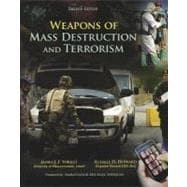
Weapons of Mass Destruction and Terrorism, Second Edition
Foreword Michael A. Sheehan
Preface
1.1 Definitions, Trends, and the Concept of "New Terrorism"
Russell D. Howard and Margaret J. Nencheck The New Terrorism
Brian Michael Jenkins The New Age of Terrorism
1.2 The Nature of the Post-9/11 WMD Terrorism Threat
Bruce Hoffman CBRN Terrorism Post-9/11
James J. F. Forest Opportunities and Limitations for WMD Terrorism
Leonard A. Cole WMD and Lessons from the Anthrax Attacks
2.1 Chemical Weapons
National Academies and Department of Homeland Security Fact Sheet: Chemical Warfare Agents, Industrial Chemicals, and Toxins
Jonathan B. Tucker Chemical Terrorism: Assessing Threats and Responses
2.2 Biological Weapons
National Academies and Department of Homeland Security Fact Sheet: Human Pathogens, Biotoxins, and Agricultural Threats
James W. Martin, George W. Christopher, and Edward M. Eitzen History of Biological Weapons: From Poisoned Darts to Intentional Epidemics
Brian Finlay The Bioterror Pipeline: Big Pharma, Patent Expirations, and New Challenges to Global Security
Benjamin Wittes Innovation's Darker Future: Biosecurity, Technologies of Mass Empowerment, and the Constitution
2.3 Radiological Weapons
National Academies and Department of Homeland Security Fact Sheet: Dirty Bombs and Other Devices
Charles D. Ferguson and Michelle M. Smith Assessing Radiological Weapons: Attack Methods and Estimated Effects
2.4 Nuclear Weapons
National Academies and Department of Homeland Security Fact Sheet: Nuclear Weapons
Morten Bremer Maerli, Annette Schaper, and Frank Barnaby The Characteristics of Nuclear Terrorist Weapons
Matthew Bunn and Anthony Wier The Seven Myths of Nuclear Terrorism
John Mueller The Atomic Terrorist?
2.5 Case Studies
David Albright and Corey Hinderstein Unraveling the A.Q. Khan and Future Proliferation Networks
Jeffrey M. Bale The North Caucasus Conflict and the Potential for Radiological Terrorism
Robert Jones, Brandon Wills, and Christopher Kang Chlorine Gas: An Evolving Hazardous Material Threat and Unconventional Weapon
3.1 Public Spaces, Transportation Networks, and Other Critical Infrastructure
Gary A. Ackerman, Jeffrey M. Bale, and Kevin S. Moran Assessing the Threat to Critical Infrastructure
Homeland Security & Defense Business Council Mass Transit Security
3.2 Chemical and Biological Threats
John McNabb Chemical and Biological Threats against Public Water Systems
Mark Wheelis, Rocco Casagrande, and Laurence V. Madden Biological Attack on Agriculture: Low-Tech, High-Impact Bioterrorism
3.3 Nuclear Reactors
Gavin Cameron Nuclear Terrorism: Reactors & Radiological Attacks after September 11
George Bunn and Chaim Braun Terrorism Potential for Research Reactors Compared with Power Reactors: Nuclear Weapons, "Dirty Bombs," and Truck Bombs
4.1 Strategy and Policy
Mary Beth Nikitin, Paul K. Kerr, and Steven A. Hildreth Proliferation Control Regimes: Background and Status
Albert J. Mauroni A Counter-WMD Strategy for the Future
Russell D. Howard Preemptive Military Doctrine: No Other Choice
4.2 Intelligence
Matthew C. Waxman Self-Defense and the Limits of WMD Intelligence
Brian Finlay Minding Our Business: The Role of the Private Sector in Managing the WMD Supply Chain
4.3 Response and Resilience
Ashton B. Carter, Michael M. May, and William J. Perry The Day After: Action Following a Nuclear Blast in a U.S. City
Ronald W. Perry and Michael K. Lindell Understanding Citizen Response to Disasters with Implications for Terrorism
4.4 Unique Challenges of Responding to Bioterrorism Threats and Attacks
Lea Ann Fracasso Developing Immunity: The Challenges of Mandating Vaccinations in the Wake of a Biological Terrorist Attack
Crystal Franco and Nidhi Bouri Environmental Decontamination Efforts Following a Large-Scale Bioterrorism Attack: Federal Progress and Remaining Gaps
Gregory D. Koblentz and Jonathan B. Tucker Tracing an Attack: The Promise and Pitfalls of Microbial Forensics
Sam Berger and Jonathan D. Moreno Public Trust, Public Health, and Public Safety: A Progressive Response to Bioterrorism
4.5 Case Studies
David Albright, Paul Brannan, and Andrea Scheel Stricker Detecting and Disrupting Illicit Nuclear Trade after A.Q. Khan
Elin Gursky, Thomas V. Inglesby, and Tara O'Toole Anthrax 2001: Observations on the Medical and Public Health Response
Robyn Pangi Consequence Management in the 1995 Sarin Attacks on the Japanese Subway System
Xavier Stewart An All-Hazards Training Center for a Catastrophic Emergency
5.1 Gregory D. Koblentz Predicting Peril or the Peril of Prediction? Assessing the Risk of CBRN Terrorism
5.2 Joshua Sinai and James J.F. Forest Threat Convergence: A Framework for Analyzing the Potential for WMD Terrorism
5.3 Forrest E. Waller, Jr. and Michael A. George Emerging WMD Technologies
5.4 Adam Dolnik and James J.F. Forest Conclusion: Appreciating the Past and Present, Anticipating the Future
Appendix
A.1 Prevention of WMD Proliferation and Terrorism Report Card (January 2010)
A.2 National Strategy for Counterterrorism (June 2011)
A.3 A National Strategy for CBRNE Standards (May 2011)
Credits
Index
The New copy of this book will include any supplemental materials advertised. Please check the title of the book to determine if it should include any access cards, study guides, lab manuals, CDs, etc.
The Used, Rental and eBook copies of this book are not guaranteed to include any supplemental materials. Typically, only the book itself is included. This is true even if the title states it includes any access cards, study guides, lab manuals, CDs, etc.